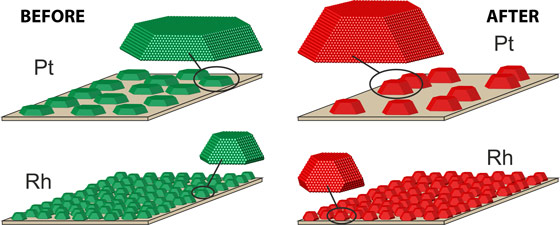- Home
- Industry
- Industry news
- Tracking live how...
Tracking live how catalysts deteriorate
17-05-2016
Synchrotron radiation makes it possible to carry out operando experiments in catalysts, where scientists can monitor nanomaterials while the catalytic reaction takes place under realistic thermal and process conditions.
Share
Company
University of Hamburg, University of Siegen, DESY, MAXIV
Challenge
Catalysts in a car contain noble metal nanoparticles consisting of rhodium, platinum and palladium and alloys thereof. These make the harmful molecules produced by the motor react on the surface of the converter while reaching high temperatures and reducing and oxidising atmospheres. When catalysts operate, the particle size of the noble metals increases. It is a process called sintering, which results in a decrease of the overall catalyst surface area. In the long run, this reduces the number of active sites from the surface and makes the catalyst less efficient.
Sample
The sample consisted of stripes of platinum-rhodium nanoparticles with varying composition from pure platinum to pure rhodium and a constant height.
Solution
Synchrotron radiation makes it possible to carry out operando experiments where scientists can monitor nanomaterials while the catalytic reaction takes place under realistic thermal and process conditions. The team used high-energy grazing incidence X-ray diffraction and online mass spectrometry.
Benefits
The experiments focused on the behaviour of the alloy nanoparticles during catalytic oxidation of carbon monoxide to carbon dioxide at a temperature of 550 K and near-atmospheric pressures. The results showed that platinum particles increase in height and lead to a reduction of the total particle surface coverage. This did not happen so much with the rhodium and rhodium-rich particles, which indicates that rhodium might be an important ingredient for catalyst stabilization.
Nature Communications, DOI: 10.1038/NCOMMS10964
 |
| While rhodium particles (lower) keep their form from the beginning (green) during the catalysis process (red), platinum particles (upper) fused together and grew substantially. |
Top image: Credits: Vanagon



